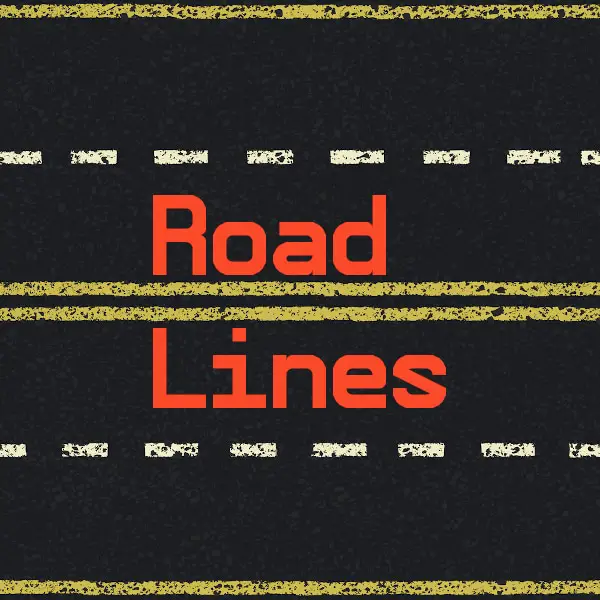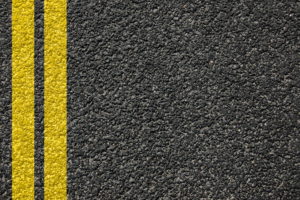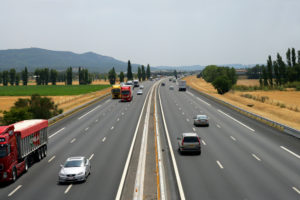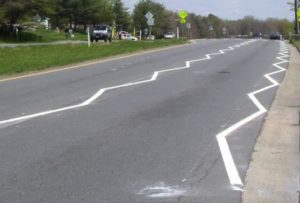Learn the meaning behind the yellow and white road lines and how to use them to maximize your safety and improve your driving on interstates and highways.

Road Lines – Yellow and White Lines Explained
Have you ever thought about road lines while you were stuck in a traffic jam? You’ll be looking at different white and yellow lines and wondering why they’re there. We’ve always been told that these lines are structured to regulate traffic and cars. But how?
If you’re here because you’ve just received your license or you’re asking out of curiosity, I’ll answer all the questions you have in mind.
The First Road lines
The first road lines are traced back to both the US and UK. In 1911 in the US, Michigan Edward insisted that there must be solid lines on the road to regulate traffic.
He took this action after he saw a milk wagon leave a white trail along the road. Later, a painted center line was done along Trenton’s River Road in Wayne Country.
While in Europe, the very first white lines are traced back to 1918 in the UK. Then in 1926, these markings were recognized as a part of the road safety protocol. Later in the 30s, these lines worked as stop signs and warning signals to direct traffic.
On the other hand, yellow lines made an appearance in the 1950s. Then dashed lines were introduced in 1956.
Road Lines in the 21st Century
As the years pass and the number of vehicles increases, road lines become more essential. They play a vital role in regulating the paths of cars to avoid accidents.
Therefore, it’s mandatory to be aware of these lines, whether you’re an experienced driver or you’ve just received your license.
There are multiple road lines available, and each has a distinct meaning and function. There are white and yellow lines. Some are straight, and others are dotted.
I shall cover each in detail below.
What Do Yellow Lines on the Road Mean?
Let’s start by understanding what the yellow lines are and their meaning. You’ll notice 4 different yellow lines, these are:
- Double solid yellow lines in the middle of the road
- The dashed yellow line in the center
- A mix of solid and dashed yellow lines in the middle
- A Yellow line on the left side of the road
1. Double and Solid Yellow in the Middle

These 2 lines separate the two lanes of traffic. They indicate that you’re not allowed to cross the other side of the road.
This means that overtaking or changing lanes is dangerous regardless of which side you’re driving on.
[/su_panel] [su_panel background=”#ffff” shadow=”2px 2px 2px #eeeeee” radius=”4″]2. Dashed Yellow Line

If you noticed a dashed yellow line in the middle of the road, it’s safe to pass a slow or a stopped car. You can cross to the other side of the road if it’s safe.
You can treat the opposite lane as a temporary one. However, you always need to use the signal in your car to warn other drivers.
[/su_panel] [su_panel background=”#ffff” shadow=”2px 2px 2px #eeeeee” radius=”4″]3. A Solid and a Dashed Yellow Line

This means that passing is only allowed to one direction of the road. If the solid yellow line is on your side, you shouldn’t leave your lane and take the other one.
However, if you’re on the dashed side, you can simply move to the other lane temporarily.
[/su_panel] [su_panel background=”#ffff” shadow=”2px 2px 2px #eeeeee” radius=”4″]4. A Yellow Line on the Left Side
If you noticed a solid yellow line running along with the left side of the road, the road is divided.
It means that there is a median that divides the road and splits it into 2 halves.
[/su_panel]What Do White Lines on the Road Mean?
Let’s move to the white lines that appear on the road. White lines separate traffic moving in the same direction and are noticeable on one-way streets.
[su_panel background=”#ffff” shadow=”2px 2px 2px #eeeeee” radius=”4″]White Lines on Both Sides

These represent the shoulder of the road and mean that you’re headed in the exact same direction as the traffic.
[/su_panel] [su_panel background=”#ffff” shadow=”2px 2px 2px #eeeeee” radius=”4″]Dashed White Lines

This white line separates lanes in the same direction. They indicate that you can change lanes with other cars, and you can also stay in that lane.
[/su_panel] [su_panel background=”#ffff” shadow=”2px 2px 2px #eeeeee” radius=”4″]Solid White Lines
These lines indicate that you shouldn’t change lanes. They’re usually used in construction areas to prevent drivers from changing lanes too many times.
Moreover, they’re used on the highway exits to mark separating lanes. They also differentiate between carpool lanes and regular traffic ones.
[/su_panel] [su_panel background=”#ffff” shadow=”2px 2px 2px #eeeeee” radius=”4″]Zigzag White Line

These are not common, and they appear on the side of the road. It means that you’re not allowed to park your car in that place.
[/su_panel] [su_panel background=”#ffff” shadow=”2px 2px 2px #eeeeee” radius=”4″]How Are They Painted?
If you’re thinking about how these lines are painted, you’ll find this part interesting.
The paint used is made from thermoplastic resin, mixed with titanium dioxide pigment, and mixed with ting glass beads. On main roads, this is applied using vehicles under computer control.
Smaller roads require more attention and effort. The paint is applied from a pram that’s heated to keep the paint color solution in its liquid form.
Although this might seem like an easy job for you, it requires some special skills. The lines need to be painted precisely at the right rate, the right thickness, and width.
The paint is made rigid and durable to face whatever nature gives from rain, snow, extreme heat, and sun.
Conclusion
Road lines have great importance in regulating traffic. They play a fundamental role in reducing the number of car accidents.
Every kind of vehicle should respect and follow these drawn lines. These lines guide traffic on all roads ranging from back country lanes to the busiest city roads.
That’s why you should have good knowledge of each line, and you should abide by the rules for your own safety and others.